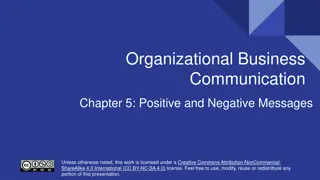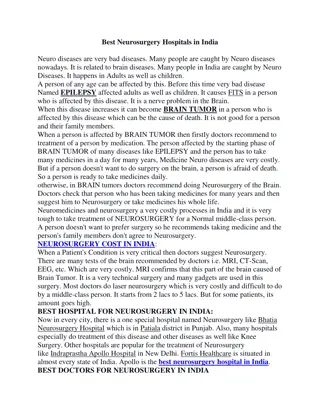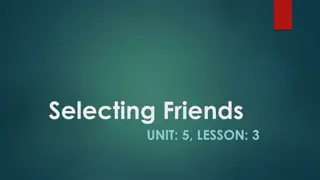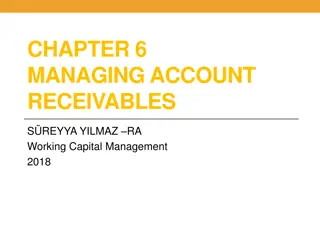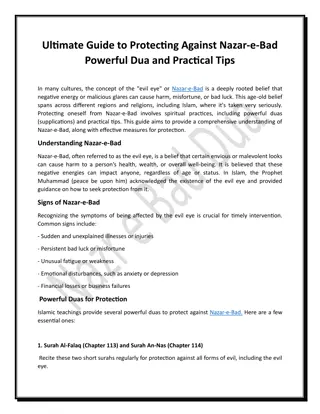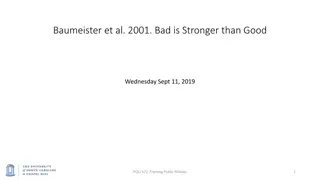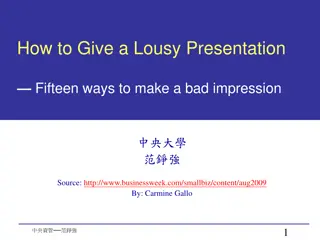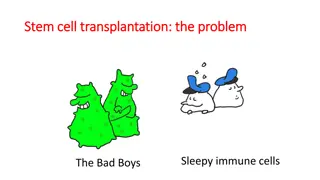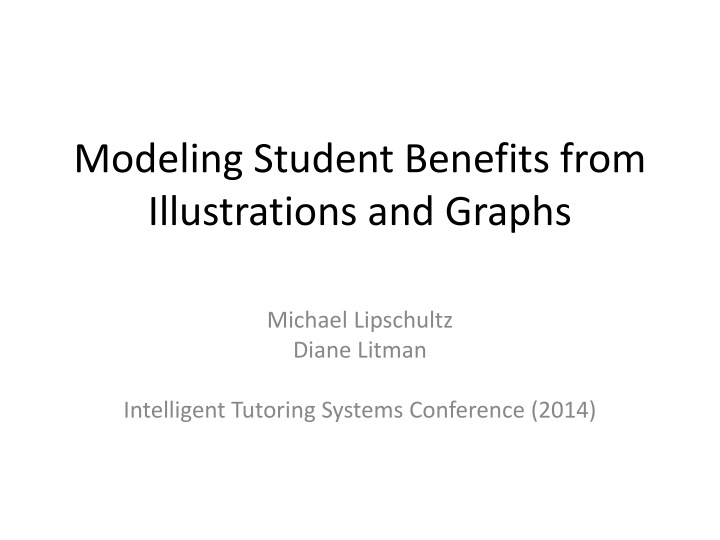
Modeling Student Benefits from Illustrations and Graphs in Educational Contexts
Discover how the use of illustrations and graphs impacts student learning in educational settings. The study delves into the effectiveness of different visual representations based on gender, knowledge, and skills, offering insights on adapting teaching methods to enhance learning outcomes. Various modeling techniques and experimental approaches are explored to identify the best representation for improved learning gains.
Download Presentation

Please find below an Image/Link to download the presentation.
The content on the website is provided AS IS for your information and personal use only. It may not be sold, licensed, or shared on other websites without obtaining consent from the author. If you encounter any issues during the download, it is possible that the publisher has removed the file from their server.
You are allowed to download the files provided on this website for personal or commercial use, subject to the condition that they are used lawfully. All files are the property of their respective owners.
The content on the website is provided AS IS for your information and personal use only. It may not be sold, licensed, or shared on other websites without obtaining consent from the author.
E N D
Presentation Transcript
Modeling Student Benefits from Illustrations and Graphs Michael Lipschultz Diane Litman Intelligent Tutoring Systems Conference (2014)
Motivation Best representation varies Gender Knowledge Skills Identify situations when illustrations or graphs improved learning gains Future: adapt to students/situations 2
Data Prior study Problem-solving + post-problem discussion Saw either illustrations only or graphs only Pretest & Post-test to measure learning gains 29 subjects: 2,042 data points Features: Student information] Student skill Domain information Contextual information 3
Modeling with Stepwise Regression 1. Stepwise Linear Regression Postscore = terms + prescore terms: representation*(tutoring context) representation*partition*rule Illustration*(PreScore=High)*(ResponseTime=Fast) For high pretesters, when ResponseTime=Fast, show illustrations Binary features Keeps only predictive terms 4
Modeling with Stepwise Regression Algorithm 1. Stepwise Linear Regression 2. Identify Problematic Rules (Potentially) Mutually Exclusive Non-Adaptive 3. Handle Problematic Rules Remove Lesser Rule in Pair 4. Relearn Model Regular Regression 5
Modeling the Best Representation: Experiment Model Types Baseline: just show one kind (illustration) 1 Factor: 1 Tutoring Context factor in term 2 Factors: Partition data along 1 variable High pretesters vs. Low pretesters 3 Factors: Partition along 2 variables 6
Modeling the Best Representation: Results 0.6 0.5 0.4 Adj. R^2 0.3 0.2 0.1 0 2 Factors 3 Factors (PreScore and ) 7
Modeling the Best Representation: PreScore Model 1. If few correct answers during walk throughs or reflection dialogues, show graphs 2. If many correct answers during session, show illustrations 3. If later in tutoring, show illustrations 4. If few correct answers in problem, show graphs High Pretesters (n=11) 1. If many correct answers during session, show illustrations 2. If few correct answers in problem, show illustrations 3. If later in tutoring, show illustrations Low Pretesters (n=18) 8
Interpreting the Model PreScore*Gender Females Males (n=8) (n=3) 1. If few correct answers in walk throughs or reflections, show graphs If many correct answers in session or problem, show illustrations If early in problem or session, show graphs 1. If few correct in reflections, show illustrations If many correct in session, show illustrations If few correct in walk throughs, show illustrations High 2. Pretesters 2. 3. 3. (n=9) (n=9) 1. If many correct answers in session, show graphs If early in session, show illustrations If many correct answers in problem, show illustrations If early in problem, show illustrations If few correct answers in reflections, show illustrations 1. If few correct answers in walk throughs or reflections, show illustrations If many correct answers in session, show illustrations If early in session or problem, show graphs If many correct answers in problem, show illustrations Low 2. 3. Pretesters 2. 4. 5. 3. 4. 9
Conclusion Developed modeling technique Unknown gold standard Handles problematic rules 5 models outperform baseline Possible to model benefit Partitioning Useful: PreScore & Gender 10
Future Work Empirical Evaluation of Model currently working on Is adapting visual representation helpful? Develop method of selecting partition features Partial correlation with postscore (covars=existing partitions)? Does modeling algorithm transfer to other tasks? Compare performance to Reinforcement Learning 11
Thank you 12


